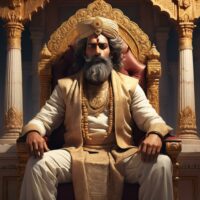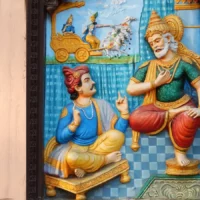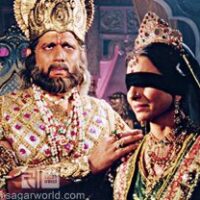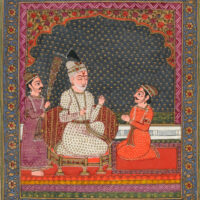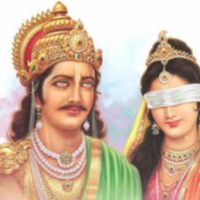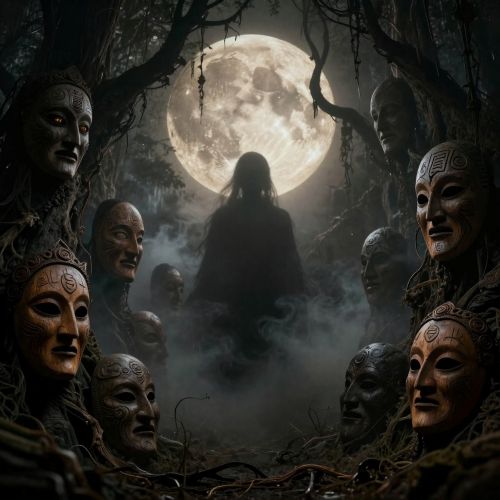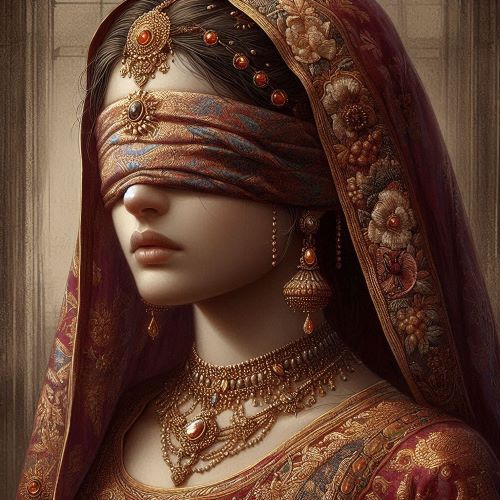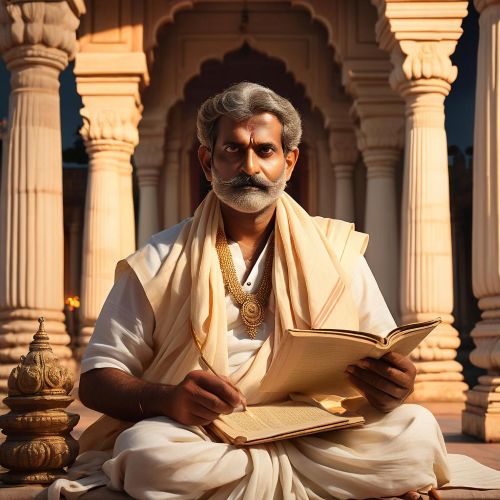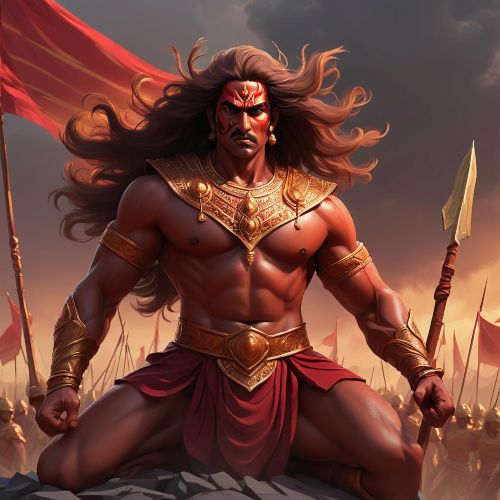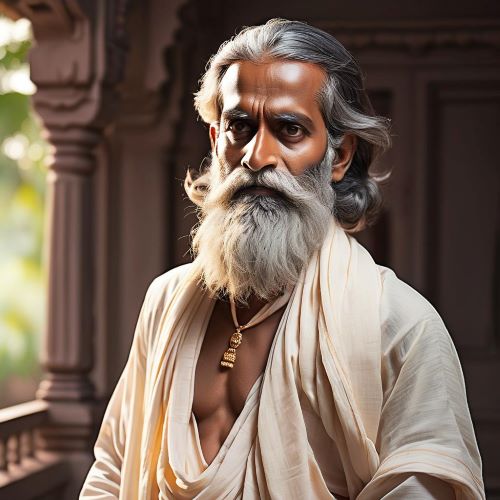Dhritarashtra : The Blind King
Listen
At a glance
| Description | |
|---|---|
| Origin | Indian Mythology |
| Classification | Mortals |
| Family Members | Veda Vyasa (Father), Ambika (Mother), Gandhari (Mother), Duryodhana and the Kauravas (Sons), Dussala (Daughter) |
| Region | India |
| Associated With | Royalty |
Dhritarashtra
Introduction
Dhritarashtra, the blind king of Hastinapura, is one of the most compelling figures in the Mahabharata. His story is not just about ruling a kingdom but also about the struggles of a man torn between love for his sons and his responsibility as a monarch. As the father of the Kauravas, his decisions—or lack of them—directly shaped the fate of the great Kurukshetra War. More than his physical blindness, it was his inability to rise above personal affection and see the demands of dharma that defined his legacy. In him, the epic presents a ruler whose humanity is inseparable from his flaws, making him both tragic and relatable.
Physical Traits
From the moment of his birth, Dhritarashtra’s blindness was both a personal burden and a political obstacle. The Mahabharata explains this condition as a result of his mother Ambika shutting her eyes during her union with Vyasa, reflecting how the inner state of the mother influenced the child. Despite this disability, Dhritarashtra possessed extraordinary strength. Legends describe him as having the power of a hundred thousand elephants, so immense that he could crush iron with his bare hands. His body radiated majesty, befitting a king of the Kuru dynasty, but this physical might was contrasted with his dependence on others for guidance. His sightless condition disqualified him from kingship at first, and this sense of rejection haunted his reign. Symbolically, his blindness represented more than a physical limitation—it foreshadowed his inability to perceive justice and truth clearly when faced with the ambitions of his sons.
Family
Born into the Kuru dynasty, Dhritarashtra’s family ties form the backbone of his story. His biological father was the sage Vyasa, while his mother Ambika was one of the queens of Vichitravirya, making him a child of the ancient custom of niyoga. His blindness prevented him from inheriting the throne, which instead went to his younger brother Pandu. His half-brother Vidura, born to a maid, was also a crucial figure, often acting as his conscience.
Dhritarashtra married Gandhari, princess of Gandhara, who chose to blindfold herself permanently in solidarity with her husband. Together, they became parents to one hundred sons—the Kauravas—and a daughter, Duhshala. His eldest son, Duryodhana, became central to the rivalry with the Pandavas, while another son, Yuyutsu, born from a maid, chose the side of the Pandavas in the war. Dhritarashtra’s deep attachment to Duryodhana often clouded his judgment, causing him to ignore injustice against the Pandavas, ultimately setting the stage for the disastrous conflict. His relationships illustrate the tension between parental love and kingly duty, a conflict he was never able to resolve.
Other names
The name Dhritarashtra itself is significant, derived from Sanskrit to mean “one who holds the kingdom.” This title reflects his position as the custodian of Hastinapura, even if his rule was marked by indecision. Beyond the Mahabharata, his name appears in Buddhist traditions, where Dhritarashtra is one of the Four Heavenly Kings, guardian of the eastern quarter and protector of the Dharma. In East Asia, he is revered under different transliterations—Jikokuten in Japanese, Chíguó Tiān in Chinese, Jiguk Cheon in Korean, and Trì Quốc Thiên in Vietnamese. These variations reveal how the name traveled across cultures, symbolizing guardianship and divine authority. In Indian tradition, however, the epithet “blind king” remains the most enduring label, underscoring how physical limitation defined his image more than his strength or wisdom.
Powers and Abilities
Dhritarashtra’s power lay not in warfare but in a combination of immense physical strength and intellectual insight. Although blind, he was said to have the strength of countless elephants, a gift from Vyasa, though his condition prevented him from displaying it in battle. His role was more advisory and reflective than martial.
One of his unique abilities came through his charioteer and confidant, Sanjaya, who was granted divine vision by Vyasa during the Kurukshetra War. This gift allowed Dhritarashtra to hear the unfolding of the great conflict in real time, despite his blindness. Through these narrations, the epic reveals some of its most philosophical and emotional passages, with Dhritarashtra questioning fate, destiny, and the role of human choice. His dialogues demonstrate a keen intellect and awareness of dharma, but his inability to act upon these insights rendered them futile. Thus, while blessed with both strength and wisdom, he remains remembered as a ruler paralyzed by his emotions.
Modern Day Influence
Dhritarashtra’s legacy extends far beyond ancient scripture, shaping cultural and intellectual discourse even today. His character embodies the pitfalls of weak leadership and excessive familial loyalty, lessons that remain relevant in modern governance and politics. Leaders who prioritize personal ties over justice are often compared to Dhritarashtra, making his name a metaphor for moral blindness.
In literature and theatre, he continues to appear as a tragic archetype—the blind patriarch whose inability to rise above attachment leads to catastrophe. His story has been retold in countless adaptations of the Mahabharata, from classical plays to modern television and cinema, where his lament after the war is often portrayed as one of the most moving moments of the epic.
Psychology also draws upon his example, analyzing his condition as symbolic of emotional blindness—where personal desires and fears obscure moral clarity. He has become a figure through which scholars explore the dangers of favoritism, indecision, and denial in leadership. For spiritual seekers, his life highlights the necessity of detachment and the importance of aligning personal duty with higher principles of dharma.
In modern India and beyond, Dhritarashtra serves both as a cautionary tale and a mirror of human vulnerability. His inability to act, despite knowing right from wrong, resonates deeply in a world where ethical leadership is constantly tested. Through his story, the Mahabharata continues to remind society that true vision lies not in physical sight but in the courage to uphold justice, even against one’s own kin.
Related Images
Source
Wikipedia contributors. (2025, August 21). Dhritarashtra. Wikipedia. https://en.wikipedia.org/wiki/Dhritarashtra
Vyasa Online. (n.d.). Dhritarashtra – Vyasa Mahabharata Encyclopedia. https://www.vyasaonline.com/encyclopedia/dhritarashtra/
Narayan, R. K. (1978). The Mahabharata: A Shortened Modern Prose Version of the Indian Epic. University of Chicago Press.
Hiltebeitel, A. (2001). Rethinking the Mahabharata: A Reader’s Guide to the Education of the Dharma King. University of Chicago Press.
Doniger, W. (2009). The Hindus: An Alternative History. Penguin Books.
Dhritarashtra | Myth and Folklore Wiki – Fandom. (n.d.). https://mythus.fandom.com/wiki/Dhritarashtra
Dhritarashtra: Significance and symbolism. (2024). https://www.wisdomlib.org/concept/dhritarashtra
Frequently Asked Questions
What is lorem Ipsum?
I am text block. Click edit button to change this text. Lorem ipsum dolor sit amet, consectetur adipiscing elit. Ut elit tellus, luctus nec ullamcorper mattis, pulvinar dapibus leo.
What is lorem Ipsum?
I am text block. Click edit button to change this text. Lorem ipsum dolor sit amet, consectetur adipiscing elit. Ut elit tellus, luctus nec ullamcorper mattis, pulvinar dapibus leo.
What is lorem Ipsum?
I am text block. Click edit button to change this text. Lorem ipsum dolor sit amet, consectetur adipiscing elit. Ut elit tellus, luctus nec ullamcorper mattis, pulvinar dapibus leo.
What is lorem Ipsum?
I am text block. Click edit button to change this text. Lorem ipsum dolor sit amet, consectetur adipiscing elit. Ut elit tellus, luctus nec ullamcorper mattis, pulvinar dapibus leo.
What is lorem Ipsum?
I am text block. Click edit button to change this text. Lorem ipsum dolor sit amet, consectetur adipiscing elit. Ut elit tellus, luctus nec ullamcorper mattis, pulvinar dapibus leo.


